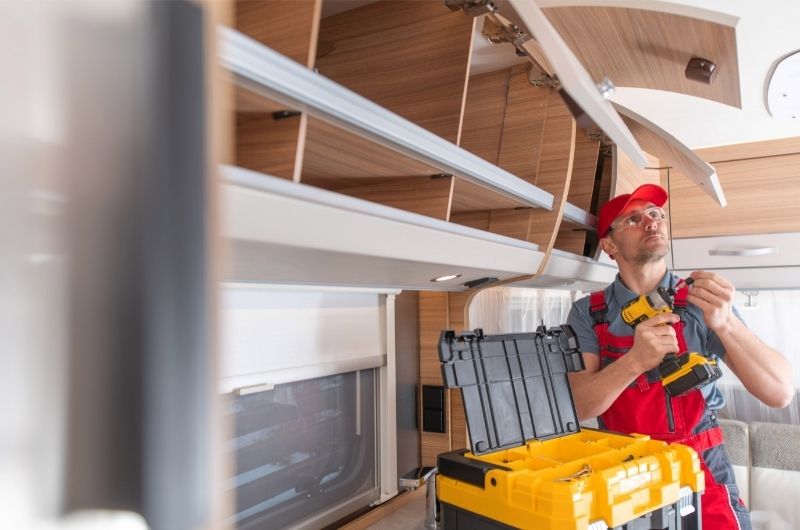Thanks for your support! If you make a purchase using our links in this article, we may make a commission. And, as an Amazon Associate, I earn from qualifying purchases. See the full disclosure here.
Have you ever wondered what RV cabinets are made of? Before you go swinging the hammer or get out the paintbrush, it’s important to understand what your RV cabinetry is made of so you can plan your project properly.
Overall, RV cabinets can be made from a wide variety of materials. Most of the time, they’ll be made out of some kind of wood or wood product. But they won’t necessarily be made from solid wood like you’d find in a house.
Let’s take a closer look at the materials used to make RV cabinets. Plus, we’ll also take a look at how to paint your cabinets and repair them if they get water damaged.
Are RV Cabinets Made From Real Wood?
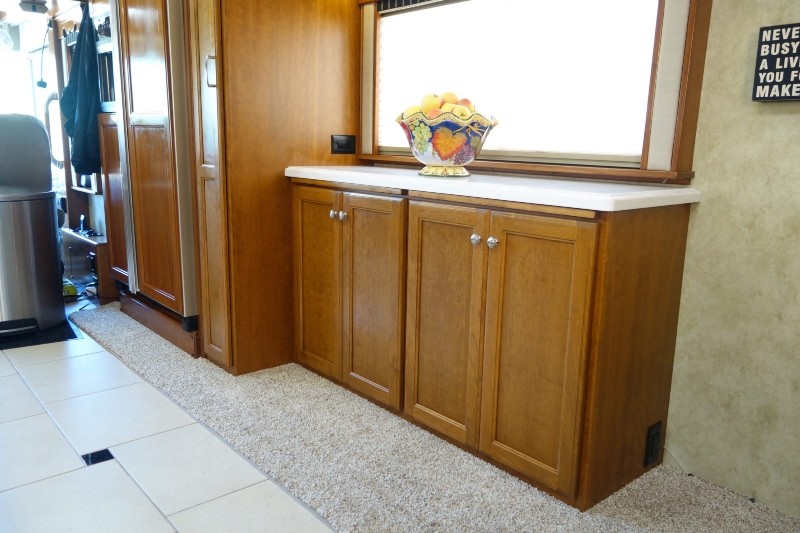
The short answer is: yes, your RV cabinets are typically made out of real wood. At least in the sense that they aren’t made of plastic or any other material.
However, your RV cabinets likely won’t be cut from a single slab of hardwood. Instead, most RV cabinets are built from some type of “engineered wood”.
Engineered wood is made by binding smaller strands or pieces of wood together. The form most people are familiar with is plywood.
Plywood was the most common option in older RVs and still sees some use today. But the most common form of wood found in modern RV cabinets is what’s known as “MDF”.
That said, if you’re shopping at the higher end of the RV market then you can find solid wood in RV cabinets, especially for cabinet doors. These will be made out of one or more whole pieces of lumber cut from some type of hardwood. Solid wood cabinets are more expensive, but also extremely durable and attractive.
Neither solid wood nor engineered wood is necessarily “better” for RV cabinets. Both have their advantages and disadvantages. But ultimately, both solid wood and engineered wood will work great for RV cabinets.
What is MDF and How is it Used in RV Campers
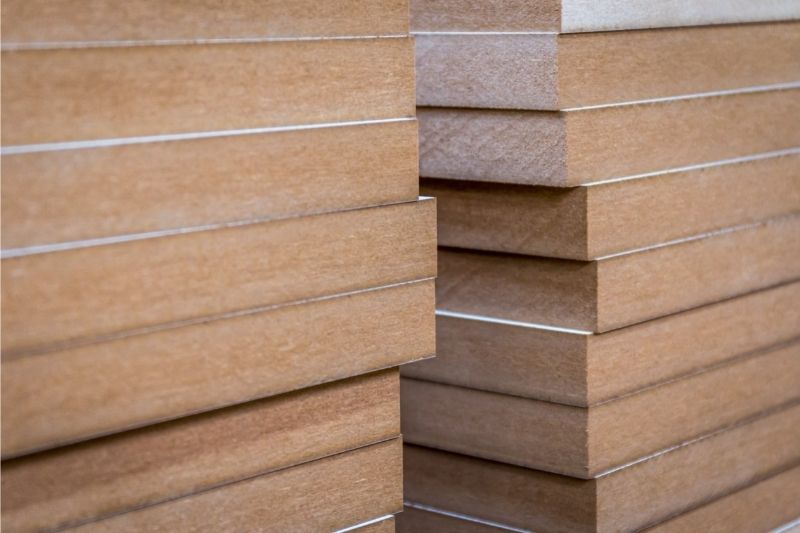
MDF stands for “medium density fiberboard”. To make this product, larger pieces of wood are first broken down into tiny fibers. Then these fibers are glued together with resin and wax and subjected to high heat and pressure. What results is an affordable piece of wood with a smooth, even surface that’s great for RV cabinets.
The Pros of MDF
MDF has a few advantages over typical plywood:
- MDF is cheaper and easier to cut. Unlike plywood, which is prone to tearing when cut, MDF can be cut cleanly from any side.
- MDF is better to paint than plywood. The smooth top layer gives you a clean canvas rather than the imperfections that come with plywood’s real wood surface.
- MDF is more stable than natural wood. RVs are exposed to humidity, road vibrations, big temperature changes, and other conditions. Medium density fiberboard won’t warp or bow under these demands.
Because of these qualities, MDF is the most common choice of wood for modern RV cabinets.
The Cons of MDF
There’s always a negative, and MDF does have a couple of downsides.
- MDF is very dense, making it heavier than plywood. This means that MDF cabinets will add a bit more weight to your RV versus plywood or hardwood.
- Plywood is also a bit stronger and holds fasteners better than MDF. While MDF is heavy, it’s softer and can split if too much weight is applied.
- MDF generates a lot of sawdust compared to plywood. If you want to DIY RV cabinets for your motorhome or travel trailer, you’ll want to have proper ventilation and PPEs.
What is Lumber Core Plywood?
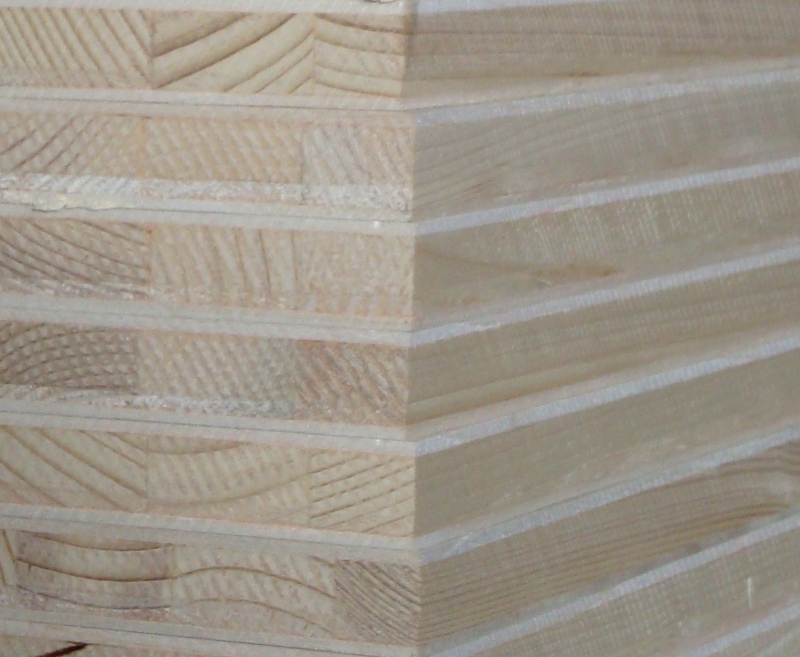
When looking at different plywoods and engineered woods, you’ll see different types of “cores”. This refers to how the inside part of the wood, between the layers of veneer, is constructed.
For example, your standard plywood, also known as “veneer core,” is made of several layers of thin strips of wood glued together. The grains of the layers are at 90 degrees to one another, giving it strength and resistance to warping.
“Lumber core” plywood refers to a type of engineered wood made by gluing together thick pieces of solid hardwood (lumber) all facing the same orientation. Then, layers of wood veneer are glued to the outer sides for strength and better aesthetics.
This construction makes lumber core plywood especially strong, durable, and can withstand being bent without breaking. Due to these qualities, lumber core is considered especially good for making long and/or wide cabinet shelves.
However, lumber core wood is more expensive than other types, such as veneer core or MDF. If you want to build DIY RV cabinets, lumber core can be a bit harder to find as well.
What Are My Cabinet Doors Made Of?
You can find a variety of different hardwoods used in RV cabinet doors, both as solid wood and as part of engineered wood. Let’s take a look at some of the most common woods used for RV cabinet doors.
Oak

Oak is a classic wood for cabinet making and is common in RV cabinets. It’s a tough, durable wood that’s also very aesthetically pleasing.
There are over 500 species of oak trees, resulting in a wide variety of different kinds of oak wood. Most commonly, you’ll see red and white oak.
Red oak is the more common option. If you imagine a piece of wood furniture, there’s a good chance the wood you imagine will be red oak. This wood is a light to medium brown, sometimes with a slight red tinge.
White oak is slightly less common than red, but still a popular option. It’s typically lighter in color than red oak, with a whitish appearance and less pronounced grain pattern. Compared to red oak, white oak is harder and more resistant to water.
Pine

Pine is another popular choice for cabinets due to its low price. Keep in mind that pine is actually a softwood, not a hardwood. So while it’s sturdy enough for cabinet making, it’s more prone to denting and damage than other types of wood.
Pine is especially popular for creating a rustic look and takes well to paint. Due to being a softwood, it’s a bit lighter weight than other typical woods used for RV cabinets.
Specially treated pine is also often used in constructing the wood frames of your RV’s sidewalls.
Hickory
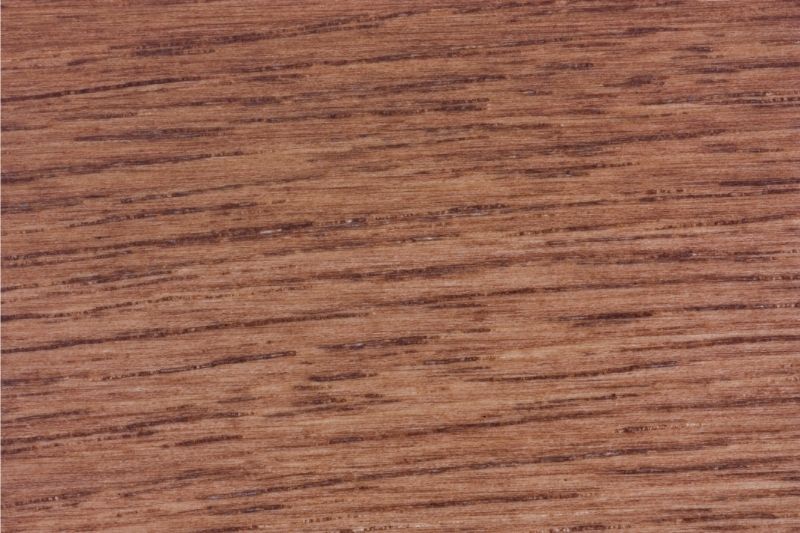
Hickory wood is extremely hard and strong. In fact, it’s among the most durable types of wood available due to its unique mix of hardness, density, and shock resistance.
Much like pine, hickory is often used to create a rustic look. Depending on the type of hickory wood, it often features contrasting light and dark brown colors that are very aesthetically pleasing.
Cherry

Cherry is an extremely popular wood for furniture for good reason. It’s an extremely attractive wood, and its color changes as it grows darker with age. Over time, the wood will take on a beautiful dark red-brown color.
Besides these qualities, cherry wood is also a fairly durable wood with good resistance to being bent. But keep in mind that it’s also one of the most expensive types of wood you’ll find in RV cabinets.
Maple

Maple is light in color with a fine grain pattern and it takes to paint and stains extremely well. It’s an incredible wood that can survive temperature changes and is resistant to cracking and warping.
Can You Paint Over RV Cabinets?
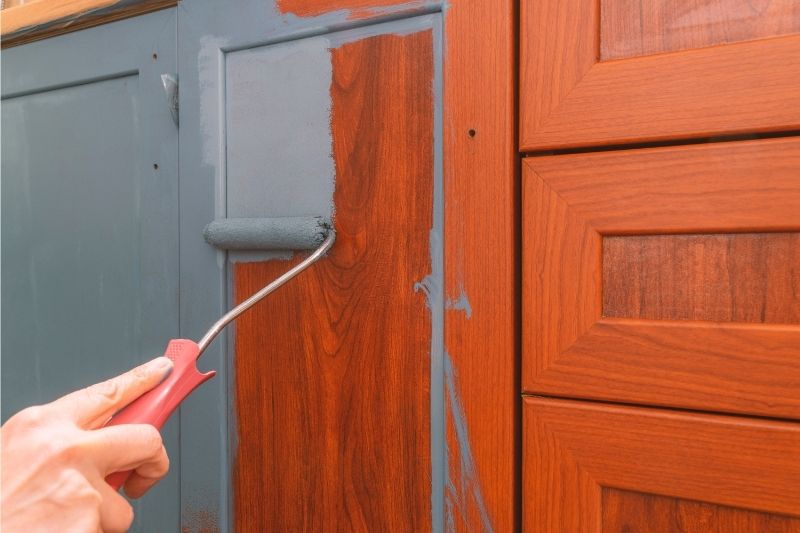
Yes, you definitely can paint over your RV cabinets. No matter what materials your cabinets are made of, painting them is possible.
When painting your RV cabinets, it’s recommended to use oil-based paint for a more durable finish. It’s also recommended to prime your cabinets before painting – this step is absolutely essential if your cabinets have any kind of vinyl or paper coating! Otherwise, any paint you apply is likely to flake off later.
Joy Kelley of Barefoot Detour explains that water-based primers can moisten the surface eventually lifting the paint or creating cracks as it dries. You can learn more about her painting techniques and tips in the February 2022 edition of RV Camping Magazine!
For pure wood cabinets, it’s possible to use an all-in-one latex paint and primer. However, while it saves time, you’ll get better results with a separate primer and paint application.
Do You Have to Sand RV Cabinets Before Painting?
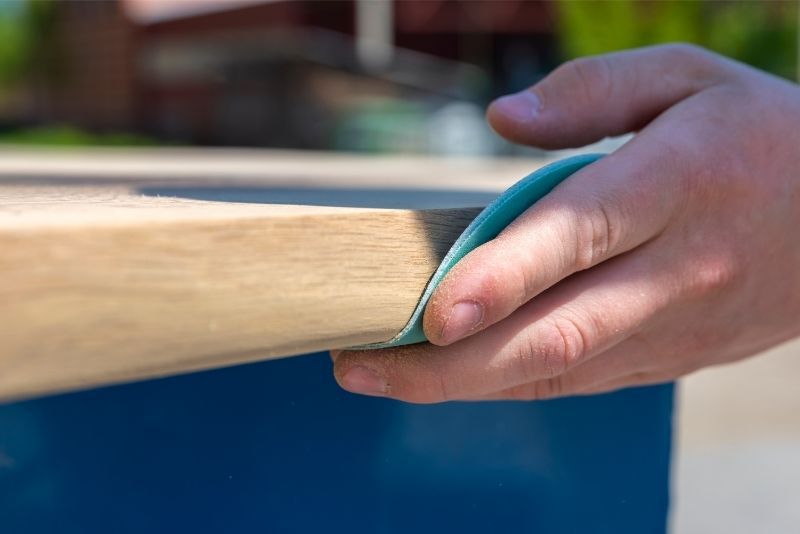
Although it’s possible to skip out on sanding your RV cabinets before painting, it’s not recommended. If you don’t, all the hard work you spend painting will likely be for naught, as the paint will soon start to chip and flake.
Instead, you’ll want to sand off the top layer of veneer, then apply an oil-based primer. This will leave you with a much better surface that paint can stick to, resulting in a better paint job that lasts longer.
It’s recommended to sand first with 120 grit sandpaper and then a final pass with 220 grit. Make sure to wipe away any dust from sanding before applying the primer. You may need to sand and prime twice to get a nice smooth finish.
What Kind of Paint Do You Use on RV Cabinets?
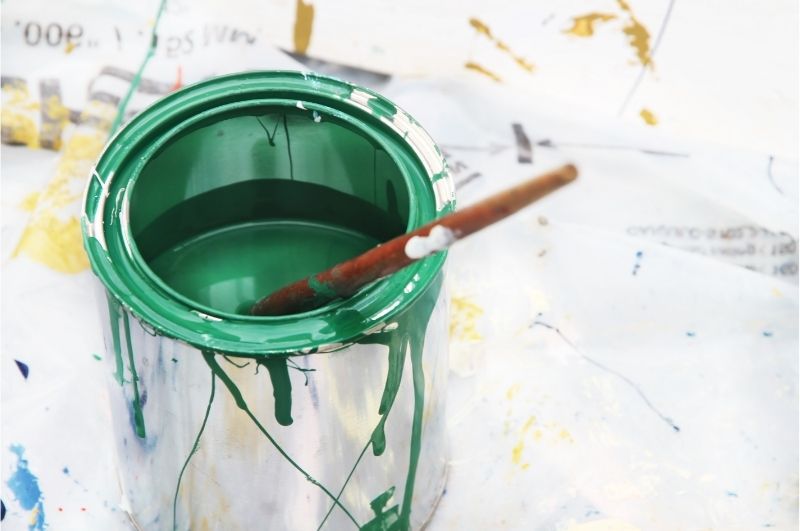
When picking paint for your RV cabinets, you should stick to oil-based paint.
Oil-based paints are more durable, more stain-resistant, and go on smoother than water-based paints. They fade less with time and are easier to clean. However, keep in mind that oil-based paints take longer to dry, have stronger smells, and are a bit more difficult to clean up.
Water-based paint, on the other hand, has a lot of major disadvantages. While it dries faster, you’ll need to undergo much more prep for the paint to adhere properly. And it’s less durable and more prone to staining.
How Do You Fix Water Damaged RV Cabinets?
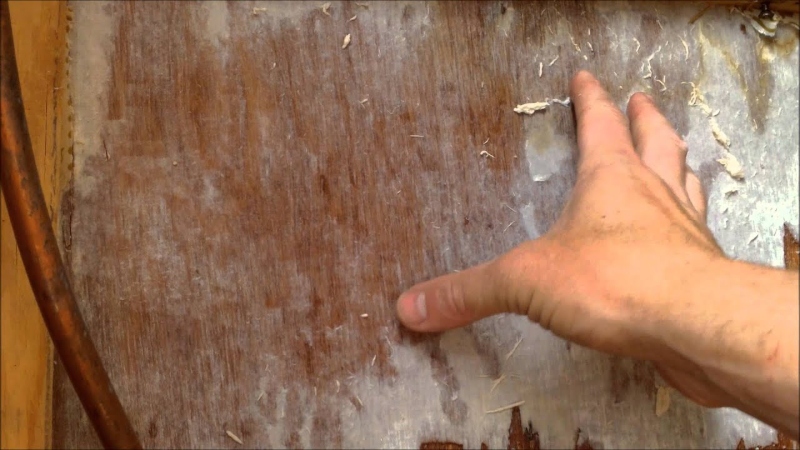
If your RV springs a leak or you find a diamond-in-the-rough RV restoration project that you just can’t turn down, there are ways to fix water-damaged cabinets.
The first step to repairing water-damaged RV cabinets is to remove the doors and any hardware such as hinges. Before doing anything else, you’ll have to wait until the wood is completely dry. Give the cabinets and cupboards time to dry out thoroughly.
Your next step is to reapply primer to the affected areas. Depending on the damage, you may also want to apply plastic wood filler to seal the damaged area. Make sure any surfaces are completely smooth.
Next, you’ll want to sand everything down. Depending on the severity of the damage, you may want to do another round of primer and/or wood filler. Once you have everything flat and smooth, it’s time to paint your RV cabinets.
From here, the process is essentially the same as painting any other cabinets.
Conclusion
Overall, your RV cabinets aren’t much different than the cabinets in a traditional home.
Most commonly, your RV cabinets will be made of some kind of engineered wood; in older models, this can be your standard plywood and in more modern RVs, you’re more likely to see MDF. In some cases, especially in higher-end or luxury RVs, RV cabinets can be made of solid wood as well.
1. RV Construction Methods: Which Is Best?
2. 12 Best Places to Buy RV Furniture
3. 7 Custom RV Manufacturers to Design Your Own RV
4. Best RV Shower Doors for Your Camper
5. DIY RV Cabinet Project to Memorialize a Pet
About the Author
Jennifer and Kendall are avid RVers and part-time van lifers who share their years of experience both as full-time RVers and nomads through writing.
Jenn and Kendall have explored Canada, the USA, and Mexico while RVing and living full-time in all 3 countries.
They have been fortunate to work not only as part of the RVBlogger team but also with RVLife, DIY RV, Camper Report, RV Magazine, Rootless Living, Vanlifers, and more.
They have also shared their RV experience through DashboardDrifters.com and are the founders of RVSpotDrop, a web service for full-time RVers.


